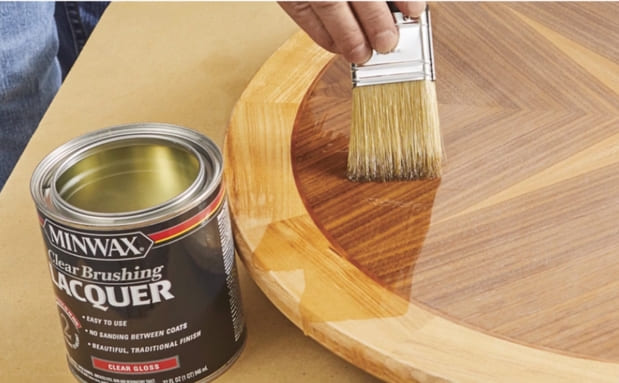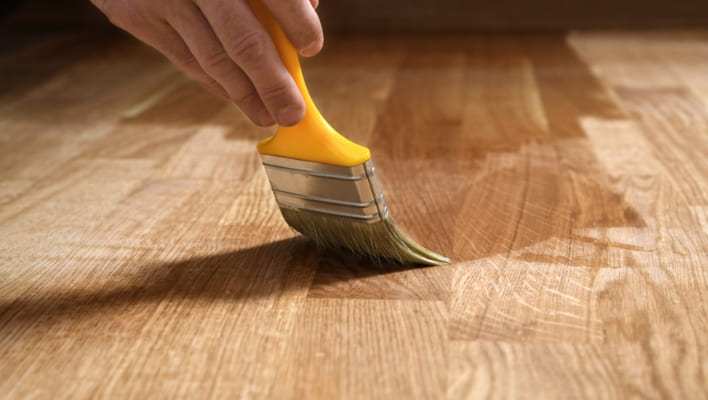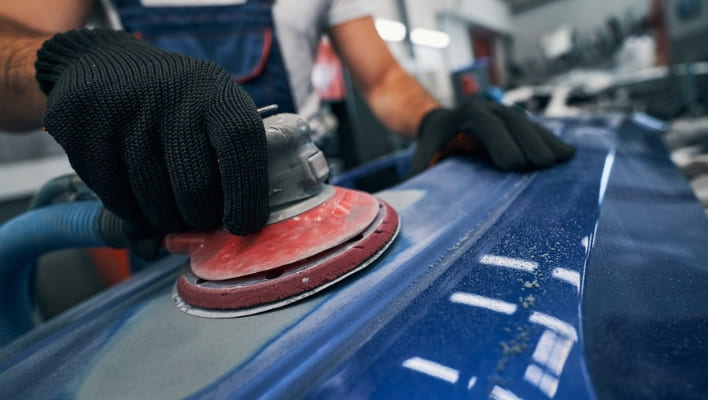A debate arises between lacquer thinner and paint thinner when it comes to cleaning and thinning lacquer. While these solvents share some similarities, they are distinct in their applications and chemical compositions. Understanding the differences between lacquer thinner and paint thinner is important for achieving the best results in your projects and ensuring safety.
Lacquer thinner is specifically designed to dissolve and remove lacquer-based coatings, while paint thinner is used with oil-based paints. Lacquer thinner can be more potent, containing harsher chemicals, while paint thinner is milder. It is essential to use the appropriate thinner for the specific coating to ensure optimal results and safety. Let’s compare lacquer thinner vs paint thinner, these two commonly used thinners to shed light on their unique properties and appropriate usage.

Table of Contents
- Paint Thinner vs Lacquer Thinner (Quick Summary)
- What is Lacquer thinner?
- What is lacquer thinner used for?
- What is paint thinner?
- Difference between Lacquer thinner and Paint thinner
- Composition:
- Purpose:
- Drying Time:
- Odor and Toxicity:
- Rich in volatile hydrocarbons
- Safety:
- Mineral spirits vs Paint thinner vs Lacquer Thinner
- Final Words On Lacquer thinner vs paint thinner
- FAQS On Lacquer thinner vs paint thinner
- Does lacquer thinner remove paint?
- Is lacquer thinner the same as paint thinner?
- Will lacquer thinner damage plastic?
- Is lacquer thinner just acetone?
- Can you use lacquer thinner in place of paint thinner?
- Will lacquer thinner melt plastic?
- What’s the difference between paint thinner and lacquer thinner?
- Will lacquer thinner damage clear coat or car paint?
- Can you use lacquer thinner to thin paint?
- Martina Hitchcock
Paint Thinner vs Lacquer Thinner (Quick Summary)
| Aspect | Lacquer Thinner | Paint Thinner |
| Composition | Strong solvents (e.g., toluene, xylene, acetone) | Milder solvents (e.g., mineral spirits, turpentine, naphtha) |
| Purpose | Dissolving lacquer-based paints and coatings | Diluting oil-based paints, varnishes, and enamels |
| Suitable for | Lacquer-based products | Oil-based paints, stains, varnishes |
| Drying Time | Fast drying | Slower drying |
| Odor | Strong and pungent | Noticeable, but milder |
| Toxicity | More toxic | Less toxic |
| Surfaces Compatibility | May damage some surfaces (e.g., plastics, certain finishes) | Safer for a broader range of materials |
| Flammability | Potentially more flammable | Less flammable |
| Versatility | Specifically for lacquer-based products | More versatile, usable with various oil-based coatings |
| Cleaning Tools | Effective for cleaning lacquer-based coatings | Suitable for cleaning oil-based paints and varnishes |
| Safety Precautions | Requires proper ventilation and protective gear | Still requires good ventilation, but less toxic |
What is Lacquer thinner?

In the world of coatings and finishes, lacquer thinner is a common solvent. It is specially formulated to dissolve and thin lacquer-based products. The glossy appearance of lacquer on wood, metal, and other surfaces is often achieved by applying a fast-drying and durable finish.
Pure lacquer thinner contains powerful solvents such as acetone, toluene, and methanol that break down the lacquer’s resins and pigments, reducing its viscosity. As a result, it is easier to apply lacquer in a thin, even coat, allowing for better control over the finishing process.
Paint Lacquer thinner is also used to clean application equipment, such as spray guns and brushes, after working with lacquer-based products. Lacquer’s solvent properties effectively remove dried or excess lacquer from tools, preserving their condition and making them ready for use in the future.
It is important to note that lacquer thinner is not suitable for thinning or cleaning other types of finishes, like oil-based paints or water-based coatings. If lacquer thinner is used with these products, it is possible to cause adverse effects and damage the surface.
Lacquer thinner is highly corrosive due to its chemical composition, so it must be handled carefully. When working with this solvent, gloves and eye protection are recommended.
Lacquer paint thinner is a hazardous chemical that requires special handling when it needs to be disposed of. It is never a good idea to pour this down the drain, as it can contaminate sources of water and negatively impact the environment. Lacquer thinner should be taken to a hazardous waste facility or a local collection center in a sealed container. For proper disposal guidelines, check with your local government, as improper handling can cause severe environmental issues.
Useful Resource: Find out which is the best paint sprayer for spraying lacquers!
What is lacquer thinner used for?
- Thinning Lacquer: Paint thinner lacquer is mainly used to thin lacquer-based paints and lacquer finishes. It is helpful in achieving the desired consistency to make application easy and the finish smooth.
- Lacquer thinner for cleaning: Lacquer thinner is effective at cleaning lacquer-based application tools such as spray guns, brushes, and rollers. It dissolves dried or excess lacquer, keeping the tools in good condition.
- Lacquer thinner to remove paint: Lacquer thinner can be used as a stripping agent to remove old or damaged lacquer finishes from surfaces.
- Fixing Imperfections: Lacquer can sometimes contain imperfections such as drips or runs. Lacquer thinner can be used to carefully blend and repair these flaws before the finish dries.
- Solvent for Certain Coatings: Alternative coatings like shellac or nitrocellulose finishes, which are closely related to lacquer, can be cleaned or thinned using lacquer thinner.
What is paint thinner?
The paint thinner, or paint solvent, is a chemical mixture widely used for the painting and finishing of surfaces. Generally, it is used to thin oil-based paints, stain and varnishes. It is paint thinner that makes coatings easier to apply and achieve the desired thickness or viscosity by altering their consistency.
In general, paint thinner is composed of a mixture of petroleum-based solvents, such as mineral spirits, naphtha, and turpentine. In oil-based paints, these solvents allow the paint to flow more smoothly and evenly on surfaces by breaking down resins and binders.
In addition to thinning paints, paint thinner serves a variety of purposes:
- Brushes, rollers, sprayers, and other painting equipment that uses oil-based products are easily cleaned with paint thinner. This tool effectively removes dried or excess paint, ensuring the tools remain in good condition and ready for future use.
- Paint thinner can be used as a stripping agent when paint needs to be removed from surfaces or objects. Paint thinner effectively softens and dissolves paint, simplifying the process of removing it from various surfaces.
- Mixed mediums such as paint thinner are often used by artists to achieve textures, blend effects, or thin washes.
- It is possible to clean up and remove paint from surfaces such as floors, furniture, and walls with paint thinner after paint spills or splatters occur during painting.
- Additionally, it serves as a valuable agent for thinning oil-based varnishes and stains, ensuring smoother application and a superior finish. Here is more information about using paint thinner.
Considering its potentially toxic nature and flammability, paint thinner should be handled carefully. To safely store and use paint thinner, ventilation, protective gear, and safe storage practices must be followed. In addition, paint thinner should not be poured down drains or disposed of with regular household waste, as it is considered a hazardous substance. In addition to ensuring personal safety, proper handling and disposal will promote environmental sustainability.
Difference between Lacquer thinner and Paint thinner
Composition:
A mixture of acetone, xylene, and toluene is used in lacquer thinner. As these solvents are powerful and fast-evaporating, they are ideal for dissolving lacquer-based paints. On the other hand, a paint thinner is a mild solvent made from naptha, mineral spirits, or turpentine. As a result, oil-based paint, varnishes, and enamels can be dissolved with it.
Purpose:
There are a number of lacquer-based products that can be thinned with lacquer thinners, including nitrocellulose lacquer and acrylic lacquer, as well as some automotive paints. It is ideal for thinning lacquer prior to spraying or brushing. A paint thinner is more versatile and can be used to dilute and clean coatings like oil-based paints, stains, and varnishes. It can also be used to clean paint sprayers, brushes, rollers, and other painting tools to achieve proper paint consistency.
Drying Time:
Lacquer paint thinner dries much faster than paint thinner because of its strong and fast-evaporating solvents. When working with lacquer-based products, this property facilitates rapid recoating and allows for faster project completion.
However, paint thinner evaporates more slowly, resulting in a slower drying process. In some instances, this may be beneficial, but may also lead to a longer waiting period between coats.
Odor and Toxicity:
Lacquer thinner usually has a more potent and pungent odor than paint thinner due to its high concentration of volatile solvents. It is also generally considered more toxic and should be used with caution in well-ventilated areas and while wearing appropriate protective gear. In contrast, paint thinner still has an odor, is less potent and less toxic than lacquer thinner. However, it is still advisable to use paint thinner in well-ventilated spaces and avoid prolonged exposure.
Rich in volatile hydrocarbons
It is generally true that lacquer thinner has a higher concentration of volatile hydrocarbons than paint thinner. It is designed specifically to dissolve lacquer-based paints and coatings, which require stronger and faster evaporating solvents to dissolve. Its volatile hydrocarbons allow it to dry quickly, making it ideal for rapid recoating.
In contrast, paint thinner is used with oil-based paints, varnishes, and enamels. In spite of containing volatile hydrocarbons, paint thinner is milder and less powerful than lacquer thinner. Therefore, paint thinner may have a slower evaporation rate, leading to extended drying times.
It is also important to note that volatile hydrocarbon differences also contribute to each thinner’s distinct odor and toxicity. Due to its higher concentration of volatile solvents, lacquer thinner often has a more pungent and potent odor than paint thinner.
Safety:
Lacquer thinners can damage some surfaces due to their strong composition, especially plastics and certain finishes. Furthermore, it can be more flammable, requiring careful handling and use.
In general, paint thinner is safer for a wider range of materials, as it is less likely to cause surface damage. Even though it is less flammable than lacquer thinner, precautions should still be observed when handling paint thinner.
Mineral spirits vs Paint thinner vs Lacquer Thinner
Mineral spirits and paint thinners are similar in their usage for thinning oil-based paint and cleaning up after painting. However, mineral spirits stand out as a milder, and more refined option with a less potent odor. Paint thinner may encompass various solvents, while lacquer thinner is specifically tailored for dissolving lacquer-based paints, offering quick drying properties for rapid recoating.
Final Words On Lacquer thinner vs paint thinner
In summary, lacquer thinner and paint thinner have distinct properties suited to different purposes. Lacquer thinner is fast-drying and specialized in lacquer-based products, while paint thinner is more versatile for oil-based coatings. Consider their compositions and intended uses to make the appropriate choice for your painting needs.
FAQS On Lacquer thinner vs paint thinner
Does lacquer thinner remove paint?
There is no doubt that lacquer thinner can remove paint, especially lacquer paint. It removes old or unwanted paint from surfaces effectively.
Is lacquer thinner the same as paint thinner?
Lacquer thinner and paint thinner are not the same. While they are both solvents used for thinning and cleaning, lacquer thinner is specifically designed for lacquer-based coatings, while paint thinner is used with oil-based paints.
Will lacquer thinner damage plastic?
Yes, lacquer thinner can damage plastic materials. Its strong solvents can cause plastic to dissolve or become discolored.
Is lacquer thinner just acetone?
No, lacquer thinner is not just acetone. While acetone is one of the components in some lacquer thinners, the formulation of lacquer thinner typically includes a blend of various solvents like toluene and methanol.
Can you use lacquer thinner in place of paint thinner?
The use of lacquer thinner instead of paint thinner is not recommended. Lacquer thinner is specifically designed for lacquer-based coatings, whereas paint thinner is used with oil-based paints. Using the wrong thinner may lead to undesirable results or damage to the finish.
Will lacquer thinner melt plastic?
Yes, lacquer thinner has the potential to melt plastic due to its powerful chemical composition.
What’s the difference between paint thinner and lacquer thinner?
In comparison, lacquer thinner is designed for lacquer-based coatings, while paint thinner is for oil-based paints. They have different chemical compositions and purposes.
Will lacquer thinner damage clear coat or car paint?
Yes, lacquer thinner can damage clear coat and car paint. Its strong solvents may strip or dull the paints finish.
Can you use lacquer thinner to thin paint?
It is not recommended to use lacquer thinner to thin paint, especially if the paint is not lacquer-based. Opt for appropriate thinners designed for the specific paint type.

Martina Hitchcock
Martina Hitchcock is a versatile author with expertise in different fields. As a paint sprayer expert, she has in-depth knowledge of paint spraying techniques, tools, and equipment. Martina is also an experienced home remodeler who has worked on various projects, including kitchen and bathroom renovations, flooring installations, and room additions. Her knowledge of home improvement and remodeling is extensive, and she enjoys sharing her insights and tips with readers. You can follow her on Facebook.


